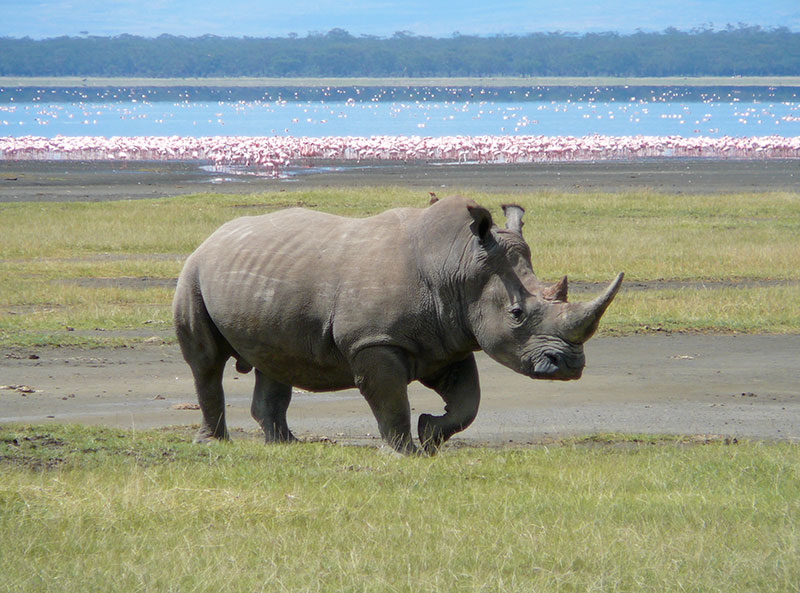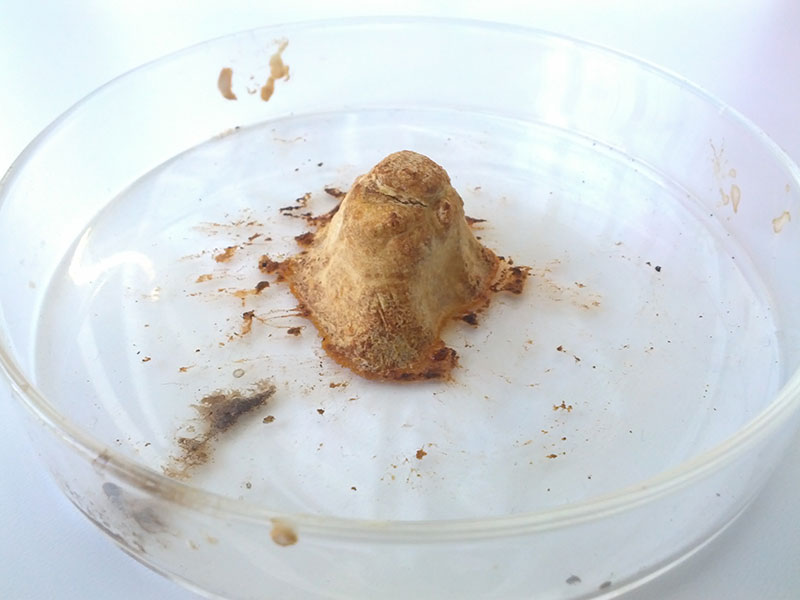- Rhino horn is now worth as much as cocaine on the black market.
- A biotech startup believes synthetic horns made in laboratories offers an ethical alternative, can confuse criminals and tap into a market worth billions.
- Matthew Markus wants synthetic rhino horn to be seen as a normal product, alongside other synthetically produced foods and medicines.
- He believes it’s a win-win situation: cultural traditions remain intact, while endangered species are not threatened with extinction.
The last male northern white rhino in the entire world stands grazing in an open field in Kenya. Four armed guards stand a few feet away from him, each facing outwards, scouring the horizon for approaching poachers. At sunset the guards hand over to a night shift who peer into the darkness, weapons ready. This is what extinction looks like.
The demand for rhinoceros horn has skyrocketed over the last few years, mostly driven by demand in Asia, where the powdered horn is highly valued for its purported medical properties. Experts have said that rhino horn is becoming more lucrative than drugs. The U.N. Office on Drugs and Crime has put the street value of rhino horn at between $1,110 and $5,550 an ounce. In comparison, gold fetches $1,198 per ounce and cocaine $4,790. A single rhino horn can fetch $100,000 in Asia.
Matthew Markus, Cofounder and CEO of Californian biotech startup Pembient, believes he might have a solution. Instead of joining forces with conservationist he’s decided to produce synthetic rhino horn, with a 3-D printer in a lab, to offer consumers an ethical alternative. Along with business partner George Bonaci (pictured above, left) they have embarked on an innovative journey to save a 50 million year-old animal from disappearing within years.
While some conservationists view his efforts as fueling demand for a product they’re trying to outlaw, Markus believes that creating a better system for rhino horn delivery is more effective than trying to change traditions and attitudes.
“We’ve been made to believe that either traditions must die or animals must die,” says Markus. “I don’t believe that to be true. Many traditional practices using rhino horn go back thousands of years and if there’s a way of obtaining these materials without the slaughter of animals, then that’s what we should be doing,” he says.
The proceeds of ivory and rhino horn poaching have also been known to fund terror groups such as al-Shabab in Somalia with illegal wildlife trafficking ranking among the world’s top criminal activities – alongside drugs, arms and human trafficking. Pembient might be seen to be saving rhinos, but the wider social problems it’s helping to solve – security and wellbeing –is a less obvious.
Markus points to Silicon Valley factory farming start ups, that develop synthetic manufacturing techniques for food to help feed a rapidly growing planet – brewing milk without a cow or eggs without a chicken. Experiments at the Pembient lab have brought rhino horn to within 80 percent of the real thing. While Markus admits that synthetic rhino horn will not stop poaching entirely, he believes the quality of his product will find a market among connoisseurs and also confuse criminal networks.
As with any great idea, imitators have already begun to appear. Markus is unfazed and knows that to get an innovative idea to market is what really counts. “They say that when you have an idea, a hundred people might have the same idea too. Only twenty-five will take it to the next step and ten might take it a step further. We are still the ones who have taken it the furthest,” he says.
Once the genetic DNA of rhino horn has been replicated it will be easier for Markus to produce other rare products, such as elephant tusk and tiger bone, that will help save other endangered species. His business goal is to capture 10-25 percent of the rhino horn market with his synthetic product – playing within the illicit wildlife trafficking market worth $8-10 billion per year, according to a WWF report by global development company Dalberg.
Markus feels his venture is not about quick opportunism, but more the culmination of a lifetime of ponderous problem solving, linked to an ethical standpoint. “To do something significant in life requires education, observation, lots of thinking and life experience,” he says. “This can take years and you sometimes have to put things aside and let time and the sum of your experiences direct you. You might never experience an ‘aha’ moment in your life – a great idea might only emerge slowly over many years.”
Leaders and innovators are often people who seek solutions by examining the way existing things are done; and then applying unfamiliar thinking to them that turns them into game-changers. Markus allowed himself to explore ideas that sounded crazy, but led to an amazing new solution that will have untold social impact.
“The one thing I liked about computer programs, in my former job as a computer scientist, is that they are so easy and inexpensive to copy,” says Markus. “One day I thought, ‘wouldn’t it be cool to copy biological objects?’ The re-emergence of the poaching crisis in 2007 and the availability of affordable technology made me realize that this type of start up might actually create a positive impact.”
Pembient also wants to create a company that hires the very best people to work on sustainability and conservation problems, instead of more frivolous things.
“I’ve met talented engineers, scientists and businesspeople who spend huge amounts of time optimizing clickthrough rates for their online ads,” says Markus. “I want to create a business that’s attractive to these people, who wake up in the morning and want to rather put a poaching syndicate out of business.”







































